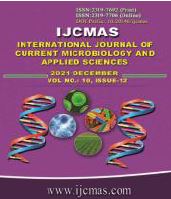


 National Academy of Agricultural Sciences (NAAS)
National Academy of Agricultural Sciences (NAAS)

|
PRINT ISSN : 2319-7692
Online ISSN : 2319-7706 Issues : 12 per year Publisher : Excellent Publishers Email : editorijcmas@gmail.com / submit@ijcmas.com Editor-in-chief: Dr.M.Prakash Index Copernicus ICV 2018: 95.39 NAAS RATING 2020: 5.38 |
The first laboratory confirmed case in Kerala was reported in Thiruvananthapuram, on 8th July 2021. Since then, 83 ZIKV positive cases have been reported from Kerala, with majority of cases from Thiruvananthapuram Municipal Corporation (TMC) area. Entomological surveillance was carried out in 19 wards of TMC including 9 micro containment wards. Three species of Aedes (Stegomyia) mosquitoes-Ae.aegypti, Ae.albopictus and Ae.vittatus could be collected from the survey areas and among this, Ae.albopictus was the predominant species. The Aedes larval indices such as House index, Container index and Breteau index were found above the critical level in all the surveyed areas. Analysis on immature Aedes output in different container types indicated flooded cement floors/water stagnated areas in newly constructing sites had the highest container productivity (43.08) followed by discarded tires (15.68) and plastic containers (11.62). The highest container/breeding site efficiency was noted in the same flooded cement floors (4.0) followed by grinding stones/cement tanks/cement pits (2.97) and in discarded tires (1.92). ZIKV could be detected from Ae.aegypti, Ae.albopictus and Ae.vittatus mosquitoes. The detection of ZIKV from Ae.albopictus and Ae.vittatus in the present study is the first report from India. Transovarial transmission could be noted in this outbreak investigation. The outbreak of ZIKV in the state capital causes a serious public health concern all over the state. The right approach will certainly rely on intensive source reduction activities and implementation of both traditional and newer vector control interventions with the active participation of the community.
 |
 |
 |
 |
 |